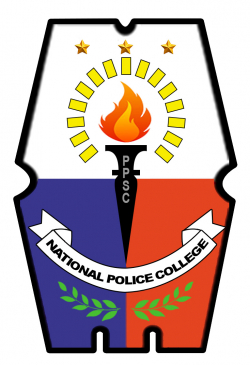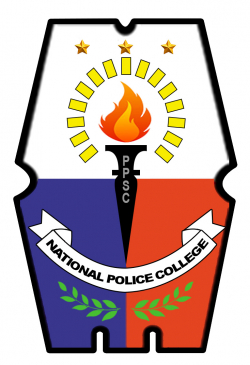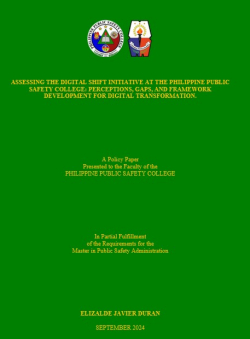PUBLIC SAFETY AND SECURITY STUDIES OF CITY OF SAN FERNANDO, PAMPANGA

Type
Thesis
Authors
PCPT MARIA JEICYL GOMBA CAPOQUIAN ( PCPT ELSA DAVID CASUPANAN PCPT SHARIN SAN DIEGO DAYAO )
Category
PSOAC
[ Browse Items ]
Publication Year
2024
Abstract
EXECUTIVE SUMMARY
Purpose and Scope: The Public Safety and Security Study for San Fernando, Pampanga, aimed to evaluate the current state of public safety and security in the city, identify key challenges, and provide actionable recommendations for enhancing safety and improving coverall security management. The study focused on police effectiveness, crime rates, traffic management, and coordination with local agencies.
Key Findings:
1. Demographics and Geography:
• Population: As of 2020, San Fernando has a population of 354,666, with 35 barangays.
• Geographic Features: The city covers 67.74 square kilometers and is a critical regional hub in Central Luzon, situated 66 km north of Manila.
2. Police and Crime Management:
• System Failure: The Crime Information Reporting and Analysis System (CIRAS) experienced a significant disruption due to a hacking incident in May 2024, affecting crime data reporting and analysis.
• Personnel Shortage: Despite meeting the required police staffing levels, there is a noticeable shortfall in effective coverage relative to the growing population, business activity, and vehicle traffic. This imbalance has increased the vulnerability of businesses and residents to criminal activities.
3. Traffic and Public Safety:
• Traffic Congestion: The city faces severe traffic congestion, with an estimated one million vehicles during the day and 400,000 at night. This has been exacerbated by the city’s infrastructure limitations and high vehicle volume.
• Traffic Violations and Accidents: There has been a significant increase in traffic violations and accidents, with traffic-related incidents reaching 98% of the previous year’s total with just six months. Common violations include unlicensed driving and lack of helmet use.
4. Coordination with Local Agencies:
• Police Coordination: Discussions with the city official and the Provincial Administrator revealed critical issues related to police manpower and traffic management.
• Disaster Management: The City Disaster Risk Management Office highlighted the need for better data on traffic incidents and emphasized the high vehicle volume emergency services.
Recommendations:
1. Enhance Police Resources:
• Action Points: Increase police manpower and optimize patrol deployment to address coverage gaps and enhance response capabilities.
2. Improve Traffic Management:
• Action Points: Develop and implement strategies to alleviate traffic congestion, such as establishing a dedicated traffic management section and exploring alternative work week arrangements for non-emergency employees.
3. Updated Technology Systems:
• Action Points: Restore and secure the CIRAS to ensure reliable crime reporting and analysis and integrate updated technology for better data management.
4. Strengthen Coordination:
• Action Points: Foster better collaboration between police, local government, and disaster management agencies to address overlapping issues and improve overall public safety.
Conclusion: The study identifies significant challenges in public safety and security in San Fernando, including system failures, police staffing issues, and traffic congestion. By implementing the recommended actions, the city can improve its safety infrastructure, enhance police effectiveness, and manage traffic more effectively.
Next Steps:
• Implementation Plan: Develop and execute a detailed action plan to address the identified issues and implement recommendations.
• Monitoring: Establish mechanisms for ongoing evaluation and adjustment of strategies to ensure continued improvement and adaptation to emerging challenges.
This summary provides an overview of the key findings and recommendations from the study, aimed at guiding stakeholders in enhancing public safety and security in San Fernando, Pampanga.
Purpose and Scope: The Public Safety and Security Study for San Fernando, Pampanga, aimed to evaluate the current state of public safety and security in the city, identify key challenges, and provide actionable recommendations for enhancing safety and improving coverall security management. The study focused on police effectiveness, crime rates, traffic management, and coordination with local agencies.
Key Findings:
1. Demographics and Geography:
• Population: As of 2020, San Fernando has a population of 354,666, with 35 barangays.
• Geographic Features: The city covers 67.74 square kilometers and is a critical regional hub in Central Luzon, situated 66 km north of Manila.
2. Police and Crime Management:
• System Failure: The Crime Information Reporting and Analysis System (CIRAS) experienced a significant disruption due to a hacking incident in May 2024, affecting crime data reporting and analysis.
• Personnel Shortage: Despite meeting the required police staffing levels, there is a noticeable shortfall in effective coverage relative to the growing population, business activity, and vehicle traffic. This imbalance has increased the vulnerability of businesses and residents to criminal activities.
3. Traffic and Public Safety:
• Traffic Congestion: The city faces severe traffic congestion, with an estimated one million vehicles during the day and 400,000 at night. This has been exacerbated by the city’s infrastructure limitations and high vehicle volume.
• Traffic Violations and Accidents: There has been a significant increase in traffic violations and accidents, with traffic-related incidents reaching 98% of the previous year’s total with just six months. Common violations include unlicensed driving and lack of helmet use.
4. Coordination with Local Agencies:
• Police Coordination: Discussions with the city official and the Provincial Administrator revealed critical issues related to police manpower and traffic management.
• Disaster Management: The City Disaster Risk Management Office highlighted the need for better data on traffic incidents and emphasized the high vehicle volume emergency services.
Recommendations:
1. Enhance Police Resources:
• Action Points: Increase police manpower and optimize patrol deployment to address coverage gaps and enhance response capabilities.
2. Improve Traffic Management:
• Action Points: Develop and implement strategies to alleviate traffic congestion, such as establishing a dedicated traffic management section and exploring alternative work week arrangements for non-emergency employees.
3. Updated Technology Systems:
• Action Points: Restore and secure the CIRAS to ensure reliable crime reporting and analysis and integrate updated technology for better data management.
4. Strengthen Coordination:
• Action Points: Foster better collaboration between police, local government, and disaster management agencies to address overlapping issues and improve overall public safety.
Conclusion: The study identifies significant challenges in public safety and security in San Fernando, including system failures, police staffing issues, and traffic congestion. By implementing the recommended actions, the city can improve its safety infrastructure, enhance police effectiveness, and manage traffic more effectively.
Next Steps:
• Implementation Plan: Develop and execute a detailed action plan to address the identified issues and implement recommendations.
• Monitoring: Establish mechanisms for ongoing evaluation and adjustment of strategies to ensure continued improvement and adaptation to emerging challenges.
This summary provides an overview of the key findings and recommendations from the study, aimed at guiding stakeholders in enhancing public safety and security in San Fernando, Pampanga.
Number of Copies
1
| Library | Accession No | Call No | Copy No | Edition | Location | Availability |
|---|---|---|---|---|---|---|
| NPC Library | 676771 | 1 | Yes |




